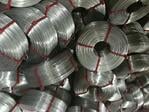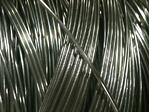 Lashing wire is used all over our country to support the telecommunications and electricity delivery systems that keep us connected and productive. From the long winters of New England to the dry heat of the Southwest, lashing wire can see some of the most extreme elements that Mother Nature can throw at it – and must be prepared to weather these climates and perform day in and day out. One way to insure that this is the case is to select the proper material grade for the environment it’s located in.
Lashing wire is used all over our country to support the telecommunications and electricity delivery systems that keep us connected and productive. From the long winters of New England to the dry heat of the Southwest, lashing wire can see some of the most extreme elements that Mother Nature can throw at it – and must be prepared to weather these climates and perform day in and day out. One way to insure that this is the case is to select the proper material grade for the environment it’s located in.
Here’s a brief primer on material choices and some background on why you would select a particular grade of lashing wire
For many years, Type 430 stainless steel was the norm that was used everywhere. It provided sufficient corrosion protection for most of the country at a reasonable price. Over time it was noticed in the industry that they had to replace the lashing wire along the coasts much more frequently than the lashing wire in the farmland. At this point Type 316 stainless steel was developed for use in coastal regions because it had much greater corrosion resistance to the salt and humidity in ocean side installations. This additional corrosion protection came at a hefty price increase per coil but since the real cost is having to re-lash, it turned out to be a big cost savings.

It was also noticed that while using Type 430 stainless steel, re-lashing had to be done more frequently in the industrialized areas of the country. This was mainly due to the increase of pollutants in the air and the ensuing acid rain. They didn’t need the full corrosion resistance offered by the Type 316 stainless steel being used along the coasts, but they needed something more corrosion resistant than Type 430 stainless steel.
 Enter Type 302 stainless steel. It was a happy medium between Type 430 stainless steel and Type 316 stainless steel. Better corrosion resistance than Type 430 stainless steel but not as expensive as Type 316 stainless steel. So, based on where you are doing your lashing, you have choices to ensure an economical life for your lashing wire. And all three of these material grades are available from the Loos & Company Wire Division.
Enter Type 302 stainless steel. It was a happy medium between Type 430 stainless steel and Type 316 stainless steel. Better corrosion resistance than Type 430 stainless steel but not as expensive as Type 316 stainless steel. So, based on where you are doing your lashing, you have choices to ensure an economical life for your lashing wire. And all three of these material grades are available from the Loos & Company Wire Division.
If you have any questions about lashing wire selection, or anything to do with wire and wire products, don’t hesitate to contact us. We’d be more than happy to work with you on your requirements. Simply contact a Loos & Company product manager today and we’ll get started for you.



